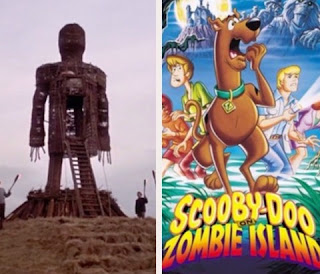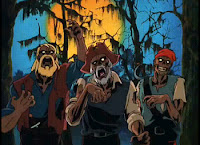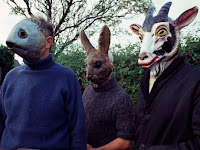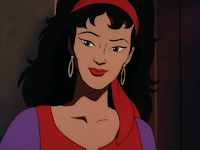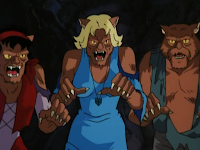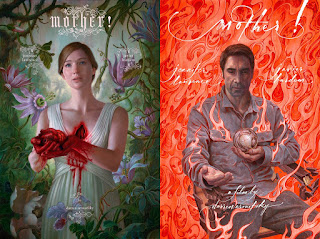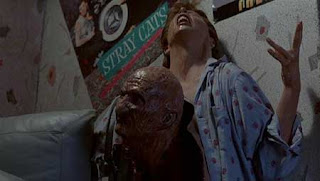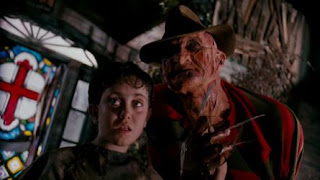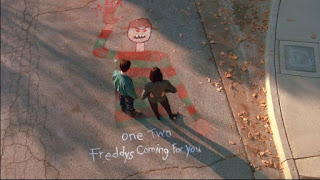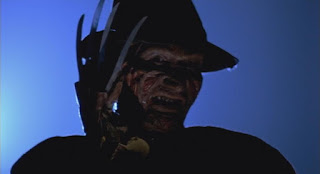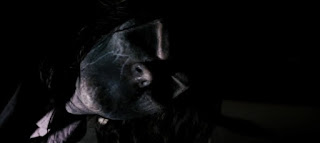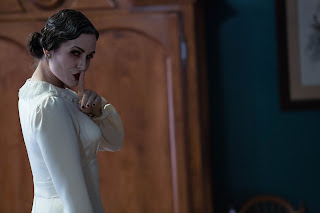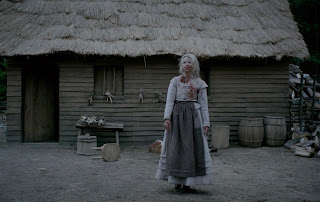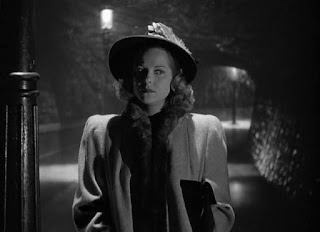So last week I wrote a piece on the
Nightmare on Elm Street films and ranked them from worst to best. After that, I was inspired to do a similar piece with the
Friday the 13th series, and after sitting through some of the most unbearable sequels ever, I have finally completed the franchise. The franchise unleashed the iconic slasher Jason Voorhees into the world, hacking his way from Camp Crystal Lake, to Manhattan (kind of), to hell, and eventually the future.. As you can tell, things get really weird in the later films. Some of the films were surprisingly quite enjoyable and still hold up well today, others however..well, you'll see. I'm not including the remake as I didn't include it in the
Nightmare on Elm Street list and felt it wouldn't be fair to do so with this. Also, mild SPOILERS ahead. Without further ado, here is my definitive ranking of the
Friday the 13th franchise.
11. Jason Goes to Hell: The Final Friday (1993)
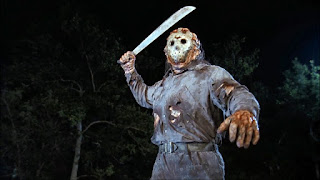
This was just woeful, absolutely woeful. The basic premise is that Jason (Kane Hodder) is blown up by the FBI and seemingly killed once and for all. However, Jason now (somehow) has the power to possess people and jumps from body to body to track down a distant relative in order to possess her and become his former self again. I know, it's just as bad as it sounds. The film doesn't just jump the shark, it jumps a whole family of them by giving Jason the ability to possess his victims. This really lets the film down in a sense, because no matter how bad these sequels got, they at least had Kane Hodder giving it his best as a really formidable Jason. However, here Hodder only gets about 10 minutes screen time as Jason, along with a brief cameo as a security guard where he is ironically killed by Jason. The film boasts some awful performances and a terrible script as well, further solidifying it as a prime example of cinematic feces. It has some merits, Steven Williams from 21 Jump Street is entertaining as bounty hunter Creighton Duke, and it has some easter eggs that reference other horror films such as the crate from Creepshow, and the Necronomicon from The Evil Dead. The final scene also teases Freddy vs Jason, although that wouldn't get released until 10 years later. An awful film altogether that makes one of the most iconic slashers of the 1980's into a mere laughing stock.
10. Friday the 13th Part VIII: Jason Takes Manhattan (1989)

Ah Jason Takes Manhattan, a more appropriate name would be Jason Takes (a boat to) Manhattan. The film is 100 minutes long, making it one of the longer entries in the franchise, yet only about 40 of those at most actually take place in the Big Apple. The other hour or so takes place on a boat bound from Crystal Lake full of partying college graduates. It's an extremely misleading title that makes the final product incredibly disappointing. But that's not all. The film has a countless number of plot holes throughout and the worst part is that they're not even subtle ones. One example is that Jason supposedly can't swim, which makes sense considering how he drowned as a child and was explicitly noted later on in Freddy vs Jason, yet he somehow manages to swim from the wrecked ship to the shores of Manhattan. Another, and my personal favourite, is that Jason somehow now has the ability to teleport. Several times during the film, he will be pursuing a potential victim, right behind them, when suddenly he appears in front of them? Have the multiple resurrections given Jason the ability to teleport? If so, why doesn't he use it to teleport out of the way of a car that hits him? I don't know why I bother questioning this utterly nonsensical film, it's a waste of time. It's only saving merits are the fact that once again, Kane Hodder is a truly menacing Jason, and that the dog manages to make it to the end. At least it does something right.
9. Jason X (2001)
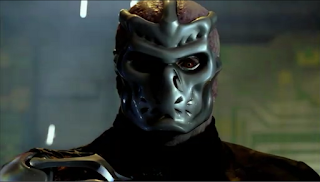
Just when you thought they couldn't milk this franchise anymore, they send Jason Voorhees (Kane Hodder one again) into the future. Yep, after being cryogenically frozen beneath the Crystal Lake Research Facility, Jason is thawed out in the future by a research crew who take him aboard their ship along with one of his surviving victims who was frozen with him. This entry is just utterly bonkers, as you can probably tell. The best way to sum it up is Alien meets Star Trek but with Jason Voorhees on board the ship and not scary. Hell, I'm sure there's even episodes of Star Trek that are scarier than this. The whole production value feels really cheap, making Jason X feel like more of a low rate TV movie than the final chapter in Jason Voorhees' life. Along with that, it's got some truly painful performances that make some TV movies look almost like Oscar winners. It ranks above Jason Takes Manhattan and Jason Goes to Hell solely for comedic value, obviously unintentional that is. From an ass-kicking, leather clad cyborg woman, to a man with a weird nipple clamp fetish (don't ask), the film is just downright bizarre, someone actually thought that this would be a good idea. Even more bizarre is the brief cameo from Canadian body horror king David Cronenberg, what the fuck was he doing in this? Much like Jason Takes Manhattan, the promotion for this film was a bit misleading, teasing the cybernetic 'Uber Jason' in all his chrome glory. However, we don't even see Uber Jason until the last twenty minutes, so the rest of the film is basically zombie, in a hockey mask, on a spaceship. I know, right? A bizarre piece of cinema altogether.
8. Friday the 13th Part III (1982)
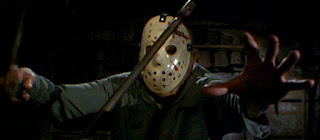
In gloriouos 3-D! Yes, the third film in the franchise is the most gimmicky of them all and relies all too heavily on the fact that it uses 3-D. There are several laughable moments where things blatantly shoot towards the screen to take advantage of the 3-D. My personal favourite is the bit with the yoyo. This is undoubtedly an important film in the franchise as it is the first time Jason (Richard Brooker) ever dons the iconic hockey mask. However, despite its eye popping gimmicks, the film is just a little bit forgettable. None of the characters are all that memorable, I mean there was that hippie looking guy, and the other guy who looks like
Freaks and Geeks era Seth Rogen, but apart from that everyone else is just disposable. If it relied more on character development than the whole 3-D thing then maybe, just maybe, it could have been a much better film. However, it pours much of its attention into the gimmick that it takes away from most of the other aspects of the film. What I will say however, is that the film does have the best opening theme of the franchise that you can listen to in all it's synthy glory
here, and that's the extended version! Overall,
Part III is largely forgettable, and just rather bland, even with that soundtrack and the outlandish 3-D sequences.
7. Friday the 13th Part VII: The New Blood (1988)
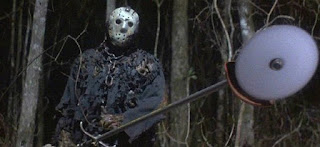
Or Carrie vs Jason as I like to call it. This film had the great idea of introducing the character of Tina (Lar Park Lincoln), a girl with telekinetic powers who was definitely not inspired by Carrie. Tina unwittingly brings Jason back from the depths of Crystal Lake with her powers while attempting to contact her dead father who she accidentally killed years ago. It's quite obvious that this is the point in which the franchise really started going downhill, the characters are all forgettable, the acting is not great, and the fact that the writers had to introduce telekinesis to the franchise just says it all. However, what the film does get right is Jason himself, and New Blood's iteration of the character is probably my favourite. This is the first time that Kane Hodder dons the hockey mask, and he manages to bring a new layer of physical menace to the character. He is sinister and slow-moving, almost like a Boris Karloff character, and he is also extremely physically imposing. He is a true force of nature that lets nothing get in his way, hacking through people and throwing them about like they're mere ragdolls. His appearance was equally menacing, covered in mud and wrapped in chains like some Dickensian spirit, he's an incredibly unsettling figure altogether. Hodder brought a sense of personality to the character which was much more refreshing for the franchise than telekinesis could ever be. It's just a shame they kept the best Jason for the worst sequels. New Blood isn't totally bad, it's not exceptionally good either, it's just kind of average to be honest.
6. Freddy vs Jason (2003)

The long awaited crossover teased ten years beforehand in Jason Goes to Hell, Freddy vs Jason is alright. It's not inherently bad, in fact it's quite funny and has plenty of service for fans of both antagonists, but it feels a little underwhelming considering the ten year wait. The film makes a point to provide Jason with a little more development, making him a somewhat sympathetic character in some ways. In this film he is manipulated by Freddy Krueger (Robert England) through the form of is mother Pamela so that he will set out to kill the teenagers of Springwood once again. Jason is played by Ken Kirzinger here, replacing Kane Hodder for some reason, and he's quite good in the role. He doesn't really get the chance to make the character his own in the same way Hodder did, however he has some really good moments such as the iconic cornfield party massacre. Out of the two villains, Jason feels like the more sympathetic one in some ways, he feels more like a pawn of Freddy than anything else. I feel like this takes away from his menace in some ways, in the past films he was just a stone cold killing machine with no mercy for any of his victims, yet here, we can't help but root for him at times. An entertaining, yet somewhat underwhelming send off to Jason, Freddy vs Jason makes him more of an antihero than a flat out baddie, which has both its merits and its disadvantages.
5. Friday the 13th: A New Beginning (1985)
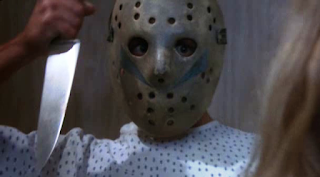
Now I'll admit I do respect the fact that this film at least tried to do something different. Instead of just ressurecting Jason like the later sequels would do, this one opts to leave the killers identity ambiguous until the end of the film. Has Jason returned from the dead? Or is someone else behind the murders? The answer is extremely underwhelming, but sure at least it tried to do something different. This is also the first film to take the action away from Crystal Lake, instead moving things to Pinehurst Halfway House where Tommy Jarvis (John Shepard) is sent to help cope with his PTSD after surviving Jasons 'final' massacre. This allows for the film to play on a number of psychological elements by utilising dream sequences and hallucinations to mess with the audiences head. This was a bold move for the film that allows it to set itself apart from the other, hardcore slashers of the franchise. However, the film has a large abundance of characters that it's hard to keep track of them all. In fact, there are times when it feels like it introduces certain characters only to kill them off in the next scene. They feel more like cattle than characters. It's an ambitious sequel at least, it acknowledges the fact that Jason is dead and attempts to take the franchise in a new direction instead of just milking things like the later sequels would do. Unfortunately, overall the film wasn't executed (lol) very well and feels a bit anticlimactic by the end of it all.
4. Friday the 13th Part II (1981)
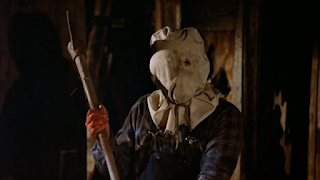
Another extremely important entry in the franchise as it is the film that establishes Jason as the primary antagonist of the series. After watching his mother die at the end of the first Friday the 13th, Jason Voorhees (Steve Daskawisz) emerges in Crystal Lake for the first time in years, killing off a new group of counsellors who have arrived at the camp. Beginning with the lone survivor of the first film, Jason slashes his way through countless teens in a vengeance-fuelles rage after the death of his mother, and if one thing is clear, Jason has watched one too many Mario Bava films. Yes, this is the film that borrows not one, but two death scenes from Bava's phenomenal giallo film A Bay of Blood. The most obvious example is the scene where two people are impaled during intercourse, while another is the scene in which wheelchair-bound Mark has a machete stuck in his head. It's clear that the film takes a lot of inspiration from A Bay of Blood, but to be honest in comparison to some of the later sequels it's not half bad. It's the film that essentially introduced us to Jason Voorhees and established him as the imposing menace that would terrorise Crystal Lake for years to come. It's a solid follow up to the first film that packs a fair amount of suspense and memorable death scenes.
3. Friday the 13th (1980)
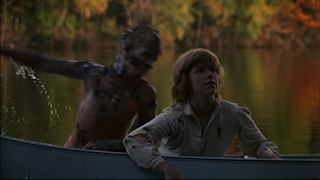
The film that started it all. After being inspired by John Carpenter's Halloween and Wes Craven's Last House on the Left, on which he worked, Sean S. Cunningham decided to make a slasher film of his own. Set at an old summer camp, the film followed a group of youths attempting to re-open the camp for the first time in years, only for a mysterious killer to start picking them off one by one. With it's POV shots and general formula, Friday the 13th clearly borrowed a lot from Halloween, yet it's distinctive location and ambiguity behind the killer's identity gave Friday the 13th it's own personality. It is quite a tense film as we watch this killer pick of the unsuspecting counsellors one by one, a formula that would inspire a number of future films such as Sleepaway Camp and The Burning. Of course, the real highlight of the film is Betsy Palmer's performance as resident maniac Pamela Voorhees. Although she only appears in the final act, Palmer is phenomenal in the role and manages to find the perfect balance between sweet old lady and maniacal killer. Her appearance is brief yet she leaves such an impact by the end of the film, it's no wonder Jason turned out to be nuts, it must run in the family. While it doesn't capture that sheer sense of dread of Halloween, or the grizzly shock value of Last House on the Left, Friday the 13th is an effective and memorable slasher flick that birthed one of the most long running horror franchises ever. Also, look out for a young Kevin Bacon.
2. Friday the 13th Part VI: Jason Lives (1986)
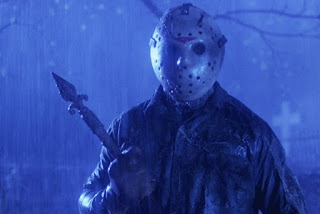
Okay, when I began watching Jason Lives I thought it was extremely dumb. The basic premise is that Tommy Jarvis (Thom Matthews) attempts to put his fears of Jason to rest for good by visiting his grave and ensuring that he is dead. Jarvis then stabs Jason with a metal rod that, by sheer coincidence, gets struck by lightning which in turn resurrects Jason. Yep, I know, it's a bizarre premise and at first I thought 'are they really doing that?', but to be honest, what follows is one of the most memorable and most fun films in the whole franchise. It's got car chases, it's got gun fights, it's got undead Jason Voorhees doing what he does best, it's an extremely enjoyable picture that breathes a breath of fresh air into the franchise. It's also got some of the best performances of the franchise, Matthews is an excellent Tommy Jarvis, playing the character with much more charm and personality than John Shepard in the previous film. Jennifer Cooke is equally enjoyable as Megan Garris and I will stand by the fact that her performance is the best of the franchise. She is just so naturally charismatic and shares an excellent chemistry with Shepard. That's one thing that Jason Lives does so well, it's characters actually feel like people as opposed to just disposable teens. We actually care about whether or not they survive and that makes the film much more effective than some of the later films. It's a fun film overall, it doesn't take itself too seriously and has a sense of almost meta-humor that lets you know that. This gives it an advantage over some of the other sequels.
1. Friday the 13th: The Final Chapter (1984)
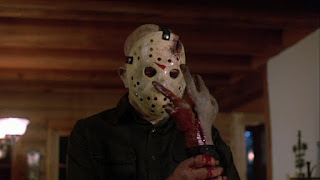
We all know that this is far from the final chapter in the franchise, but it is by far the best. Initially intended as the concluding film in the series, The Final Chapter is the definitive Friday the 13th film. After being presumed dead after the events of Part III, Jason Voorhees (Ted White) breaks out of the morgue and returns to Crystal Lake for another gruesome killing spree. The film has the most layered plot of the franchise, not just focusing on a group of teenagers, but also on a local family and man named Rob (E. Erich Anderson) who has a personal vendetta against Jason. All of these subplots weave into each other nicely, making for a stronger narrative in comparison to the previous films. Much like Jason Lives, this film also has some really likable characters that we can actually get behind and root for. Some notable highlights are Jimmy (Crispin Glover), a shy introvert hoping to prove that he isn't a 'dead fuck', and the young Tommy Jarvis (Corey Feldman), a boy with a penchant for horror movie masks. This allows us to invest our interest in the characters, raising the stakes of the film. The Final Chapter also boasts some of the most grizzly death scenes of the franchise, courtesy of a talented special effects team that included SFX maestro Tom Savini. My personal favourite is when Jason takes out a morgue attendant with a saw before twisting his neck around. It's definitely the heaviest on the gore. The Final Chapter would have been the perfect way to end the franchise, it had a strong narrative, likable characters, grizzly deaths, and put Jason to rest for good (or what seemed to be for good). It also has an iconic dance scene where Crispin Hellion Glover lets loose. The Final Chapter takes everything that's good about the franchise and rolls it all up into an excellent little slasher flick that still holds up today.
Sitting through some of these films made the Nightmare on Elm Street franchise feel like the pinnacle of cinema. The later films were especially poor and were almost painful to watch at times. However, the franchise does have its standout moments, along with some memorable death scenes and some decent performances. Jason himself is also a truly menacing villain, especially during the Hodder era which is a shame considering how awful those films were. It's been a bizarre journey overall, taking the action from New Jersey, to Manhattan, to four hundred years into the future, Jason's had some mad adventures over the years. I'm just glad I won't ever have to watch Jason Goes to Hell again. I suppose it's only right that I start on the Halloween sequels as soon to finish off this trilogy of terror. Until next time.
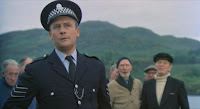 Now The Wicker Man also begins with an investigator, this time Sgt. Howie, being called off to an island to investigate a mystery. The Island is Summerisle, a small island located in the outer Hebrides that is supposedly renowned for it's apples. Again, at first it seems like Howie's investigation is a perfectly normal one, but we all know there's much more at stake on Summerisle. So straight off the bat, both films involve individuals being called to an island to solve a mystery. As the film progresses however, we learn that there is a darker secret lying on each respective island waiting on the protagonists. Coincidence? Perhaps not..
Now The Wicker Man also begins with an investigator, this time Sgt. Howie, being called off to an island to investigate a mystery. The Island is Summerisle, a small island located in the outer Hebrides that is supposedly renowned for it's apples. Again, at first it seems like Howie's investigation is a perfectly normal one, but we all know there's much more at stake on Summerisle. So straight off the bat, both films involve individuals being called to an island to solve a mystery. As the film progresses however, we learn that there is a darker secret lying on each respective island waiting on the protagonists. Coincidence? Perhaps not.. When Scooby arrives on Moonscar Island, he realises that not only is he the only dog on the island, but that the islands owner Ms. Lenoir (horror legend Adrienne Barbeau) owns a large number of pet cats. This leaves Scooby as an outcast of sorts, mistrusted by Lenoir due to her cat-loving tendencies, which makes him feel a bit isolated on the island. It's not easy being a dog stuck in a world dominated by cats, as Scooby soon finds out.
When Scooby arrives on Moonscar Island, he realises that not only is he the only dog on the island, but that the islands owner Ms. Lenoir (horror legend Adrienne Barbeau) owns a large number of pet cats. This leaves Scooby as an outcast of sorts, mistrusted by Lenoir due to her cat-loving tendencies, which makes him feel a bit isolated on the island. It's not easy being a dog stuck in a world dominated by cats, as Scooby soon finds out.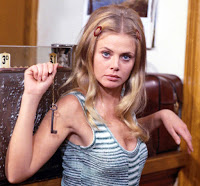 When Howie arrives on Summerisle, he is introduced to the landlord's daughter, a beautiful young woman named Willow (Britt Ekland) who appears to take a liking to him. The celibate Howie finds it difficult to resist Willow's charms, and there is an infamous scene in which she sings to him from the room next to his, hoping to entice him. Howie struggles to maintain his celibacy around Willow and at one point almost breaks it. Towards the end, Willow is also revealed to be in on the overall conspiracy, much like Lena in Zombie Island. She too had become friendly and flirty with Howie, only to turn against him in the films final act.
When Howie arrives on Summerisle, he is introduced to the landlord's daughter, a beautiful young woman named Willow (Britt Ekland) who appears to take a liking to him. The celibate Howie finds it difficult to resist Willow's charms, and there is an infamous scene in which she sings to him from the room next to his, hoping to entice him. Howie struggles to maintain his celibacy around Willow and at one point almost breaks it. Towards the end, Willow is also revealed to be in on the overall conspiracy, much like Lena in Zombie Island. She too had become friendly and flirty with Howie, only to turn against him in the films final act.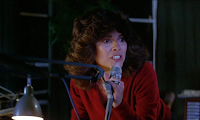 As I have mentioned, Adrienne Barbeau takes on the role of Ms. Lenoir in Zombie Island, the owner of Moonscar Island and the films primary antagonist. Initially she comes across as friendly towards Mystery Inc. much like her employee Lena. However, she too has a sinister side that comes out towards the films climax. By the films release in 1998 Barbeau was already an established icon in the horror genre, starring in films such as The Fog and Creepshow while also being married to the horror master himself John Carpenter between 1979 and 1984. Casting her as the films antagonist brought a new layer of villainy to the character due to those prior links to the horror genre, and Barbeau is excellent at bringing out the different layers of Ms. Lenoir.
As I have mentioned, Adrienne Barbeau takes on the role of Ms. Lenoir in Zombie Island, the owner of Moonscar Island and the films primary antagonist. Initially she comes across as friendly towards Mystery Inc. much like her employee Lena. However, she too has a sinister side that comes out towards the films climax. By the films release in 1998 Barbeau was already an established icon in the horror genre, starring in films such as The Fog and Creepshow while also being married to the horror master himself John Carpenter between 1979 and 1984. Casting her as the films antagonist brought a new layer of villainy to the character due to those prior links to the horror genre, and Barbeau is excellent at bringing out the different layers of Ms. Lenoir.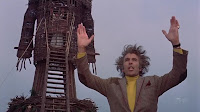 The Wicker Man also had a horror legend in the role of the antagonist, this time Dracula himself, Christopher Lee. The actor who had been most famous for his roles in countless Hammer horror films was looking to do a more grounded horror film, ultimately signing onto The Wicker Man. He also plays the owner of an island, Lord Summerisle, who acts as the films primary antagonist. Summerisle initially comes off as a charming man who is kind towards the rather stern Sgt. Howie, however, towards the end of the film it is clear that he will do anything to keep the gods happy. Lee brings his signature sense of sinister charm to the role, giving him a chance to really showcase his acting chops in comparison to some of his other roles. I believe it was one of his favourite roles.
The Wicker Man also had a horror legend in the role of the antagonist, this time Dracula himself, Christopher Lee. The actor who had been most famous for his roles in countless Hammer horror films was looking to do a more grounded horror film, ultimately signing onto The Wicker Man. He also plays the owner of an island, Lord Summerisle, who acts as the films primary antagonist. Summerisle initially comes off as a charming man who is kind towards the rather stern Sgt. Howie, however, towards the end of the film it is clear that he will do anything to keep the gods happy. Lee brings his signature sense of sinister charm to the role, giving him a chance to really showcase his acting chops in comparison to some of his other roles. I believe it was one of his favourite roles.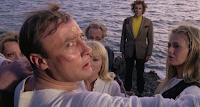 Similarly, Summerisle is also populated by members of a pagan cult, although this is a given piece of information from the beginning. However, the big surprise comes at the end when it is revealed that Howie was called to the island for the purpose of being a sacrifice himself. It is revealed that the crops on Summerisle are failing, and Lord Summerisle believes that only a human sacrifice can please the gods of the harvest and save their crops. Howie fit their qualifications for a sacrifice and was called to the island in the beginning so that he could eventually be used as such. Both the people of Moonscar Island and Summerisle are part of pagan cults who have lured the protagonists to the island in order to eventually sacrifice them for their own personal gain. This is the most striking similarity between both films and is a major plot point in both The Wicker Man and Scooby Doo on Zombie Island.
Similarly, Summerisle is also populated by members of a pagan cult, although this is a given piece of information from the beginning. However, the big surprise comes at the end when it is revealed that Howie was called to the island for the purpose of being a sacrifice himself. It is revealed that the crops on Summerisle are failing, and Lord Summerisle believes that only a human sacrifice can please the gods of the harvest and save their crops. Howie fit their qualifications for a sacrifice and was called to the island in the beginning so that he could eventually be used as such. Both the people of Moonscar Island and Summerisle are part of pagan cults who have lured the protagonists to the island in order to eventually sacrifice them for their own personal gain. This is the most striking similarity between both films and is a major plot point in both The Wicker Man and Scooby Doo on Zombie Island. 